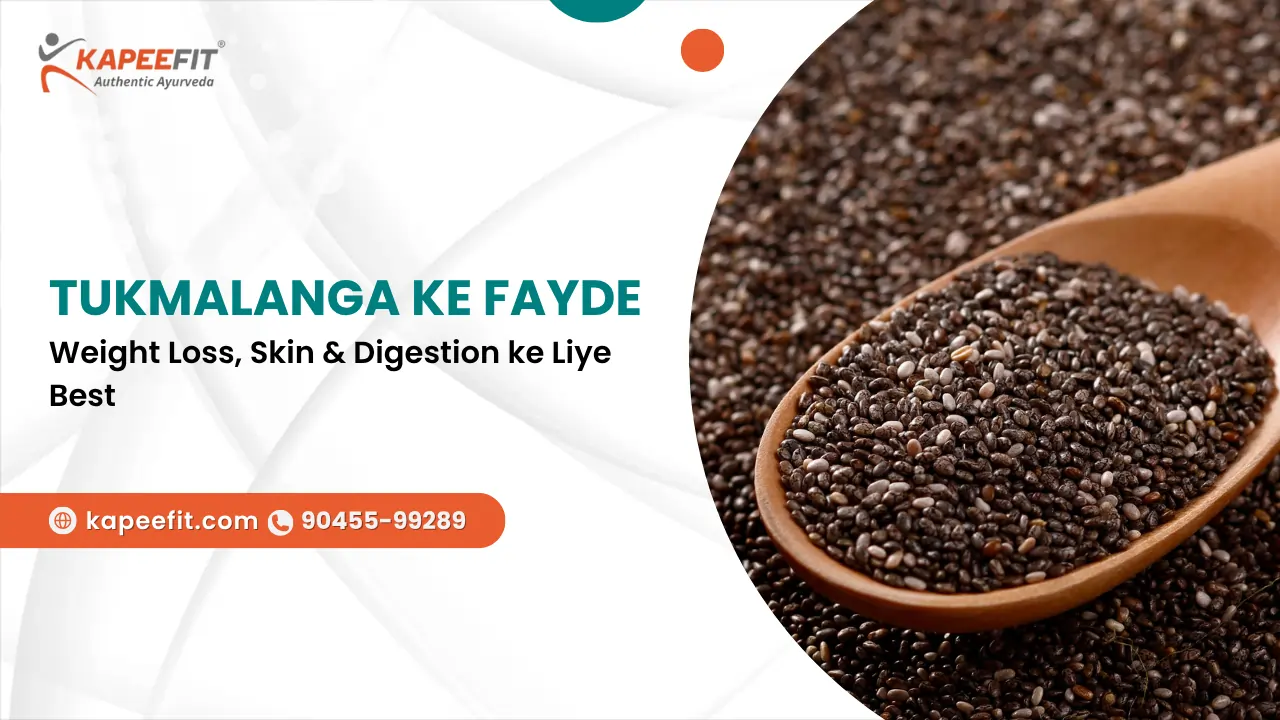Blog
HOME / BLOG
Tukmalanga ke Fayde: Weight Loss, Skin & Digestion ke Liye Best

Tukmalanga, jise hum Sabja seeds ya Basil seeds ke naam se bhi jaante hain, ek prakar ke beej hote hain jo Tulsi ke paudhe (Ocimum basilicum) se milte hain. Inhe soak karke khaya jaata hai, aur ye pani mein bhigone ke baad jelly-like ho jaate hain – bilkul chia seeds ki tarah.
Tukmalanga ka taste neutral hota hai, lekin iska cooling effect aur health benefits ise Ayurvedic aur natural healing world mein kaafi popular bana dete hain. Ye mainly summer drinks, detox water aur Ayurvedic remedies mein use kiye jaate hain.
🧘♂️ Iska Ayurvedic Importance
Ayurveda ke mutabik, Tukmalanga tridosh-nashak hai – yani ye Vata, Pitta aur Kapha tino ko balance karta hai. Iski sheet taseer (cooling nature) ke kaaran, ye body ka temperature balance karta hai aur pachan tantra (digestive system) ko sudharne mein madad karta hai.
Iske alawa, Ayurvedic texts Tukmalanga ko:
- Pachak (digestive),
- Manashakti vardhak (mind-soothing), aur
- Vyayam ke baad sharir ko calm karne wala ek natural tonic bhi maante hain.
Table of Contents
Sabja aur Tukmalanga mein kya farak hai?
Bahut log Sabja aur Tukmalanga ko same samajhte hain, lekin kuch subtle differences hain:
| Factor | Sabja Seeds | Chia Seeds |
|---|---|---|
| Paudha | Tulsi (Basil) | Salvia hispanica |
| Soaking Time | 10–15 minutes | 1–2 hours |
| Taseer | Thandi (Cooling) | Neutral |
| Color | Kaala aur shiny | Thoda greyish ya brown |
| Ayurveda Link | Strong Ayurvedic use | Western superfood ke roop mein popular |
👉 Note: Tukmalanga = Sabja seeds (India mein ye interchangeably use hote hain), lekin chia seeds alag hote hain.
Tukmalanga ke Top 7 Fayde (With Explanation)
Tukmalanga ya Sabja seeds sirf ek cooling agent nahi, balki ek Ayurvedic superfood bhi hain. Chaliye jaante hain iske 7 major health benefits, jinhe aap apne daily lifestyle mein use karke natural wellness pa sakte hain.
| Fayda | Explanation (Hinglish) |
|---|---|
| 1. Weight Loss | Tukmalanga bhook ko control karta hai aur metabolism ko boost karta hai |
| 2. Skin Health | Antioxidants se bhara hai, jo acne aur dull skin se ladta hai |
| 3. Digestion Sudharna | Pachan tantra ko strong banata hai aur constipation door karta hai |
| 4. Diabetes Control | Blood sugar level ko regulate karne mein madad karta hai |
| 5. Body Cooling | Body heat kam karta hai, especially garmi ke mausam mein |
| 6. Stress & Anxiety Relief | Nervous system ko relax karta hai, neend aur mood dono improve karta hai |
| 7. Heart Health | Cholesterol ko kam karne aur heart ko healthy rakhne mein madad karta hai |
Weight Loss mein Madadgar
Tukmalanga paani mein bhigone ke baad fibrous gel mein badal jaata hai. Jab aap ise consume karte ho, to:
- Pet der tak bhara rehta hai (fullness effect),
- Aap over-eating se bach jaate hain,
- Metabolism bhi active hota hai.
Use Tip: 1 glass lemon water + 1 tsp soaked Tukmalanga – subah khaali pet.
Skin Ko Banaye Glowing aur Acne-Free
Ismein high amount of antioxidants hote hain jo:
- Free radicals ko neutralize karte hain,
- Acne, dullness aur ageing signs ko reduce karte hain.
Bonus: Vitamin A aur K ke natural sources hone ki wajah se skin repair mein madad milti hai.
Digestion Ko Strong Banata Hai
Tukmalanga ek natural digestive tonic hai:
- Iska soluble fiber constipation door karta hai,
- Pachan tantra ko detoxify karta hai,
- Acidity aur bloating mein bhi relief deta hai.
Use Tip: After meal 1 tsp soaked seeds pani ya buttermilk mein lein.
Diabetes Patients Ke Liye Beneficial
Tukmalanga ka gel-forming fiber glucose absorption ko slow karta hai:
- Isse blood sugar spike nahi hoti,
- Long-term sugar control mein madad milti hai.
Caution: Diabetic patients use karein only after doctor consultation.
Natural Cooling Agent – Body Heat Kam Kare
Garmi ke mausam mein jab body heat badh jaati hai to:
- Tukmalanga ek natural coolant ki tarah kaam karta hai,
- Heatstroke, mouth ulcers aur skin rashes mein beneficial hota hai.
Best Summer Drink: Rose Sharbat + Soaked Tukmalanga = Instant cooling
Stress Aur Anxiety Ko Kam Kare
Ayurvedic belief ke mutabik, Tukmalanga:
- Nervous system ko calm karta hai,
- Sleep quality improve karta hai,
- Anxiety, restlessness aur irritability mein relief deta hai.
Evening Routine Tip: Warm milk + 1 tsp soaked Tukmalanga for better sleep.
Heart Ko Rakhe Healthy
Tukmalanga ke fiber aur antioxidant content se:
- Bad cholesterol (LDL) kam hota hai,
- Blood pressure balance mein aata hai,
- Heart attack aur stroke ka risk kam hota hai.
Heart Friendly Combo: Daily soaked seeds with low-fat curd ya smoothies.
Kaise aur Kab Khayein Tukmalanga Seeds?
Tukmalanga seeds ka sahi tareeka se upyog karna bahut zaroori hai, tabhi aap uske poore Ayurvedic fayde le paayenge. Galat tarike se khane par kuch logon ko gas, allergy ya discomfort ho sakta hai. Chaliye jaante hain Tukmalanga khane ka sahi tarika, sahi time, aur kuch creative ways to consume it.
Tukmalanga Ko Kaise Bhigoein? (Basic Preparation Method)
| Step | Detail |
|---|---|
| Quantity | 1 teaspoon (per person) |
| Soaking Medium | Normal ya thanda paani |
| Soaking Time | 10–15 minutes (jab tak seeds gelatinous na ho jaayein) |
| Ratio | 1 tsp seeds : 1 cup paani |
Note: Kabhi bhi seeds ko bina bhigoye directly na khayein, warna digestion mein dikkat ho sakti hai.
Tukmalanga Khane ka Best Time (Usage Timing Table)
| Time of Day | Benefit | Usage Suggestion |
|---|---|---|
| Subah khaali pet | Weight loss, detox | Nimbu pani ya honey water ke saath |
| Lunch ke baad | Digestion, acidity relief | Chhachh (buttermilk) mein daalkar |
| Shaam ko | Body cooling, stress relief | Rose sharbat ya nariyal paani ke saath |
| Raat ko sone se pehle | Sleep, anxiety relief | Halka garam doodh + soaked seeds |
Tukmalanga Khane Ke Creative Tareeke
- Detox Drink:
Nimbu pani + honey + soaked Tukmalanga - Smoothie Booster:
Fruit smoothie ya banana shake mein add karein - Falooda Style Dessert:
Rabdi, kulfi ya falooda mein daalkar khayein - Weight Loss Water:
Overnight detox water + tukmalanga + cucumber/lemon slices - Sharbat Add-On:
Rose, khus ya sandal sharbat mein 1 tsp soaked seeds
Important Tips & Precautions:
- Hamesha bhigo kar hi khayein
- Diabetic, pregnant aur kidney patients doctor se poochh kar use karein
- Daily 1–2 tsp se zyada na lein (excess fiber se bloating ho sakti hai)
- Bacchon ko dene se pehle quantity kam rakhein
Here is the detailed section on “Tukmalanga ke Side Effects aur Kaun Na Khaye” in Hinglish, complete with a clear table format and practical warnings for safe usage.
Tukmalanga ke Side Effects aur Kaun Na Khaye
Chahe koi bhi superfood ho, agar galat tareeke se liya jaaye ya kisi specific health condition mein use kiya jaaye, to side effects ho sakte hain — Tukmalanga bhi usse alag nahi hai.
Yeh section aapko batayega:
- Kin logon ko Tukmalanga se parhez karna chahiye
- Zyada matra mein lene se kya nuksaan ho sakte hain
- Kaise safe limit maintain karein
Common Side Effects of Tukmalanga Seeds
| Side Effect | Kya Hota Hai & Kyu Hota Hai |
|---|---|
| Bloating aur Gas | Fiber zyada hone se kuch logon ka pet ful jaata hai |
| Allergic Reaction | Itching, swelling, rashes – agar kisi ko seed allergy hai |
| Choking Hazard | Agar bina bhigoye khaya jaye to seed gala mein chipak sakta hai |
| Low Blood Sugar | Diabetic medicine ke saath lein to sugar aur kam ho sakta hai |
| Thandi Taseer ke Reactions | Zyada thand lagna, sinus trigger, ya cold symptoms worsen ho sakte hain |
Kin Logon Ko Tukmalanga Nahi Khana Chahiye?
| Category | Reason | Suggestion |
|---|---|---|
| 👶 Chhote Bacche (Below 5 years) | Choking hazard ka risk | Doctor ki advice se hi de |
| 🤰 Pregnant Women | Hormonal aur digestion related issues ho sakte hain | Doctor ki guidance lena zaroori |
| 💉 Diabetic Patients | Hypoglycemia ka risk, esp. with meds | Blood sugar monitor karte rahein |
| ❄️ Cold/Sinus ke Mareez | Thandi taseer se symptoms worsen ho sakte hain | Avoid karein ya kabhi-kabhi lein |
| 🧬 Allergy-Prone Individuals | Seeds allergy ho sakti hai | Allergy test ya patch test kara sakte hain |
Extra Safety Tips:
- Hamesha bhigo kar hi khayein – at least 10–15 minutes in clean water.
- Din mein 1–2 tsp se zyada na lein unless advised by a health expert.
- Pehli baar use kar rahe hain? Half tsp se start karein aur observe karein.
- High protein ya high fiber diet pe hain? To Tukmalanga limited use karein.
“Healthy cheez bhi galat tareeke se li jaye to body pe burden padta hai.”
Isliye Tukmalanga ko balance mein, routine ke hisaab se aur health condition dekh kar hi use karein.
Tukmalanga Khareedte Waqt Kya Dhyan Rakhein?
Aap healthy lifestyle follow kar rahe hain aur Tukmalanga ko apne routine mein include karna chahte hain — lekin agar aap galat quality ke seeds kharid lete hain, to uske benefits milne ke bajaye nuksaan ho sakta hai.
Is section mein aapko milega:
- Original Tukmalanga pehchaanne ka tareeka
- Best quality choose karne ke points
- Organic vs regular seeds ka comparison
| Factor | Original / High-Quality Tukmalanga | Duplicate / Low-Grade Seeds |
|---|---|---|
| Color | Shiny black, uniform size | Mixed colors, dull or brownish |
| Soaking Time | 10–15 minutes mein jelly texture | Zyada time lagta hai ya jelly banti hi nahi |
| Smell | Neutral ya mild herbal | Slightly musty ya chemical smell |
| Taste | Neutral, thoda earthy | Kadwa ya stale taste |
| Packaging | Air-tight, labeled with expiry | No label or loose packaging |
| Branding | Trusted Ayurvedic/FMCG brands | Local ya unknown source |
Tukmalanga Kharidne ke Smart Tips:
- Certified Brands Choose Karein
✔ Patanjali, Organic India, 24 Mantra, Devsiddhi Ayurveda jaise trusted brands par bharosa karein. - Label Check Karein
- Expiry date
- Manufacturing date
- FSSAI license (India mein mandatory hota hai)
- Packaging Quality Dekhein
- Moisture-proof ho
- Transparent pack ho to seeds clearly dikh sakein
- Organic Variant Prefer Karein (If Budget Allows)
- Pesticide-free aur naturally processed hote hain
- Thoda mehenga zaroor hota hai, lekin long-term ke liye better hota hai
- Online Kharidte Waqt Reviews Padhein
- Product ke reviews aur ratings check karein
- “Verified Purchase” tag wale reviews zyada authentic hote hain
Kai brands Tukmalanga infused sharbat, detox mix ya weight loss blends bhi offer karte hain – agar aap busy schedule mein hain to wo ready-to-use options bhi helpful hote hain.
“Sahi product, sahi tareeke se liya jaye — tabhi asli fayda milta hai.”
Isliye Tukmalanga kharidte waqt cheap price ke chakkar mein na padhein. Quality compromise na karein, kyunki yeh aapki sehat ka sawaal hai.
Here is the final section of your blog in Hinglish:
Conclusion – Apne Routine Mein Tukmalanga Ko Kaise Include Karein (Recap & Tips)
Tukmalanga yaani Sabja seeds ek simple aur natural superfood hai jo aapke daily health routine mein asaani se shamil ho sakta hai. Chahe aap weight loss, skin glow, acidity relief ya cooling effect ke liye use karein — iske fayde scientifically aur Ayurvedically dono proven hain.
Aaiye ek quick recap karein aur jaan lein ki isse daily life mein kaise use karein:
Tukmalanga ke Key Benefits – Jaldi se Recap:
✅ Bhook control aur metabolism boost – weight loss ke liye
✅ Skin detox aur acne reduction – natural glow ke liye
✅ Constipation aur acidity relief – digestive health ke liye
✅ Sugar balance – diabetics ke liye support
✅ Body heat kam – summer ke liye best cooling agent
✅ Anxiety & sleep relief – mind calming properties
✅ Heart health improve – cholesterol & BP control
Daily Life Mein Kaise Include Karein?
| Time | Use Idea | Purpose |
|---|---|---|
| Subah | Nimbu paani + soaked seeds | Detox aur weight loss |
| Lunch ke baad | Buttermilk/chhachh mein | Digestion support |
| Shaam | Rose sharbat + Tukmalanga | Cooling effect |
| Raat | Doodh + soaked seeds | Better sleep & relaxatio |
Pro Tips for Best Results:
- Hamesha bhigo kar khayein (10–15 minutes minimum)
- 1–2 tsp per day is safe and sufficient
- Overuse se bachein – fiber overload ho sakta hai
- Bachon, pregnant women, aur health patients doctor se consult karein
“Tukmalanga ek chhoti si cheez hai jo bade-bade health problems mein natural madadgar ho sakti hai — bas regularity aur sahi tareeke ki zaroorat hai.”
Apne daily drinks, smoothies, desserts ya detox waters mein ise shamil karein, aur dheere-dheere iska long-term health impact khud mehsoos karein.
Is this article helpful?
What Our Patients Say
EXCELLENT












